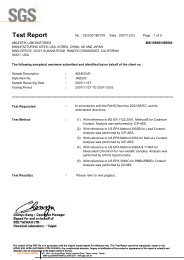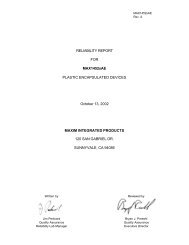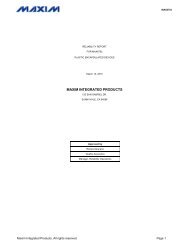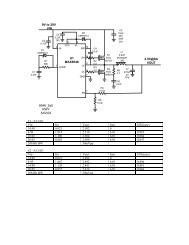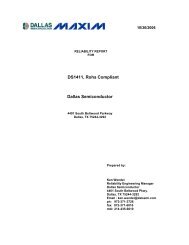MAX8640Y - Maxim
MAX8640Y - Maxim
MAX8640Y - Maxim
You also want an ePaper? Increase the reach of your titles
YUMPU automatically turns print PDFs into web optimized ePapers that Google loves.
V. Quality Assurance Information<br />
A. Quality Assurance Contacts: Ken Wendel (Director, Reliability Engineering)<br />
Bryan Preeshl (Managing Director of QA)<br />
B. Outgoing Inspection Level: 0.1% for all electrical parameters guaranteed by the Datasheet.<br />
0.1% For all Visual Defects.<br />
C. Observed Outgoing Defect Rate: < 50 ppm<br />
D. Sampling Plan: Mil-Std-105D<br />
VI. Reliability Evaluation<br />
A. Accelerated Life Test<br />
<strong>MAX8640Y</strong>/ZEXT24+<br />
The results of the 135°C biased (static) life test are shown in Table 1. Using these results, the Failure Rate ( ) is calculated as<br />
follows:<br />
= 1 = 1.83 (Chi square value for MTTF upper limit)<br />
MTTF 192 x 4340 x 44 x 2<br />
(where 4340 = Temperature Acceleration factor assuming an activation energy of 0.8eV)<br />
= 24.4 x 10 -9<br />
= 24.4 F.I.T. (60% confidence level @ 25°C)<br />
The following failure rate represents data collected from <strong>Maxim</strong>’s reliability monitor program. <strong>Maxim</strong> performs quarterly 1000<br />
hour life test monitors on its processes. This data is published in the Product Reliability Report found at http://www.maxim-ic.com/.<br />
Current monitor data for the S4 Process results in a FIT Rate of 4.6 @ 25C and 79.2 @ 55C (0.8 eV, 60% UCL)<br />
B. Moisture Resistance Tests<br />
The industry standard 85°C/85%RH or HAST testing is monitored per device process once a quarter.<br />
C. E.S.D. and Latch-Up Testing<br />
The PN82 die type has been found to have all pins able to withstand a HBM transient pulse of +/-2500 V per JEDEC<br />
JESD22-A114-D. Latch-Up testing has shown that this device withstands a current of +/-200 mA.<br />
<strong>Maxim</strong> Integrated Products. All rights reserved. Page 4/5



